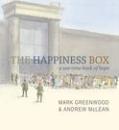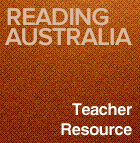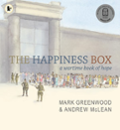AustLit
Latest Issues
AbstractHistoryArchive Description
'In 1942, Sergeant “Griff” Griffin was a prisoner of war. With Christmas approaching, he decided to make a book for the children cooped up in nearby Changi Prison. The book was said to contain the secrets to happiness. But the enemy was suspicious … With this picture book, award winners Mark Greenwood and Andrew McLean bring to life the inspirational true story of a book that became a National Treasure.'
Source: Publisher's blurb.
Reading Australia
This work has Reading Australia teaching resources.
Unit Suitable For AC: Year 4 (NSW Stage 2)
Duration 4–5 weeks, several sessions per week
Curriculum Summary
A summary table for Australian Curriculum: English content descriptions and NSW Syllabus outcomes for this unit
Themes
Anzac Day, bravery, Compassion, friendship, happiness, hope, war
General Capabilities
Critical and Creative Thinking, Literacy, Personal and Social Capability
Notes
-
Narrative non-fiction.
Publication Details of Only Known VersionEarliest 2 Known Versions of
Works about this Work
-
Forging Truth from Facts : Trauma, Historicity and Australian Children's Picture Books
2020
single work
criticism
— Appears in: The Lion and the Unicorn , September vol. 44 no. 3 2020; (p. 281-301) 'Though they can find themselves constrained by the imagined “demands of children’s literature as sanitary, benign, and didactic” (Tribunella 102), children’s picture book authors and illustrators regularly attempt to engage with “unimaginable, unspeakable, and un-representable horror” (Trezise 43). Whether it be in the form of genocide, war, persecution or displacement, they tend not to shy away from the atrocities of history when searching for subject matter. However, the balancing of the sanitary with the unimaginable demands a compromise. Authors and illustrators invariably soften, perhaps even distort the horror in their efforts to be morally instructive. In their creation of a “parable of war” (MacCallum-Stewart 177) they explore the underlying humanist principles of the stories they tell, rather than historical perspectives. This approach transforms historical particularities into “universals of human experience” (Stephens 238). Trauma is sometimes directly confronted, but this is the exception rather than the rule (Kertzer, “Anxiety” 208). Kidd contends that at “least some of the children’s literature of atrocity turns away from rather than confronts the difficulties of its subject matter, opting for simplistic narratives of character empowerment adapted from self-help literature” (185). For in any battle between hope and trauma, or at least the ones played out in children’s literature, the former usually emerges triumphant. As a result, books such as the three analyzed in this article are often very successful in exploring broader issues of personal morality, but they make for dubious history. The critical and commercial success of works that adopt this approach suggests that the book buying public share this preference for morality tales over historical accuracy.' (Introduction) -
[Review] The Happiness Box : A Wartime Book of Hope
2018
single work
review
— Appears in: Magpies : Talking About Books for Children , July vol. 33 no. 3 2018; (p. 24)
— Review of The Happiness Box : A Wartime Book of Hope 2018 single work picture book
-
[Review] The Happiness Box : A Wartime Book of Hope
2018
single work
review
— Appears in: Magpies : Talking About Books for Children , July vol. 33 no. 3 2018; (p. 24)
— Review of The Happiness Box : A Wartime Book of Hope 2018 single work picture book -
Forging Truth from Facts : Trauma, Historicity and Australian Children's Picture Books
2020
single work
criticism
— Appears in: The Lion and the Unicorn , September vol. 44 no. 3 2020; (p. 281-301) 'Though they can find themselves constrained by the imagined “demands of children’s literature as sanitary, benign, and didactic” (Tribunella 102), children’s picture book authors and illustrators regularly attempt to engage with “unimaginable, unspeakable, and un-representable horror” (Trezise 43). Whether it be in the form of genocide, war, persecution or displacement, they tend not to shy away from the atrocities of history when searching for subject matter. However, the balancing of the sanitary with the unimaginable demands a compromise. Authors and illustrators invariably soften, perhaps even distort the horror in their efforts to be morally instructive. In their creation of a “parable of war” (MacCallum-Stewart 177) they explore the underlying humanist principles of the stories they tell, rather than historical perspectives. This approach transforms historical particularities into “universals of human experience” (Stephens 238). Trauma is sometimes directly confronted, but this is the exception rather than the rule (Kertzer, “Anxiety” 208). Kidd contends that at “least some of the children’s literature of atrocity turns away from rather than confronts the difficulties of its subject matter, opting for simplistic narratives of character empowerment adapted from self-help literature” (185). For in any battle between hope and trauma, or at least the ones played out in children’s literature, the former usually emerges triumphant. As a result, books such as the three analyzed in this article are often very successful in exploring broader issues of personal morality, but they make for dubious history. The critical and commercial success of works that adopt this approach suggests that the book buying public share this preference for morality tales over historical accuracy.' (Introduction)
Awards
- 2019 shortlisted CBCA Book of the Year Awards — Eve Pownall Award for Information Books
- 2019 CBCA Book of the Year Awards — Notable Book — Eve Pownall Award
- The Happiness Box 1947 single work picture book
-
Changi,
cSingapore,cSoutheast Asia, South and East Asia, Asia,







